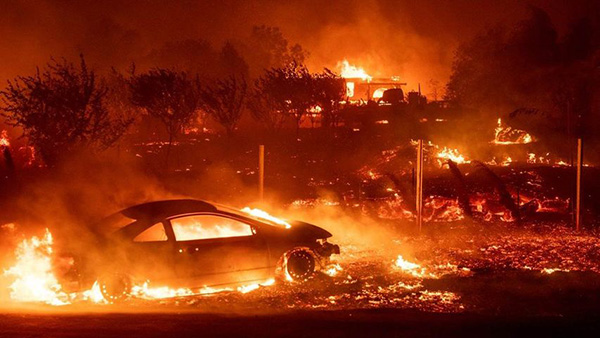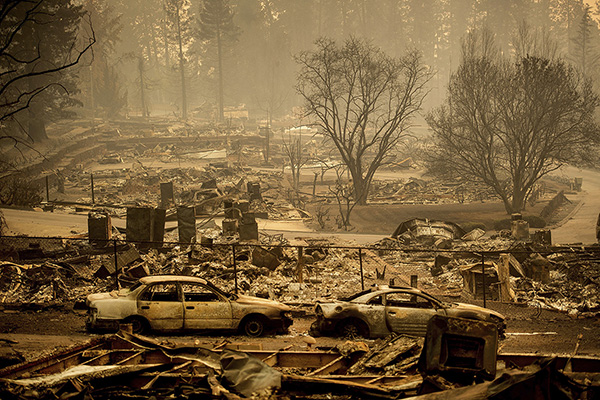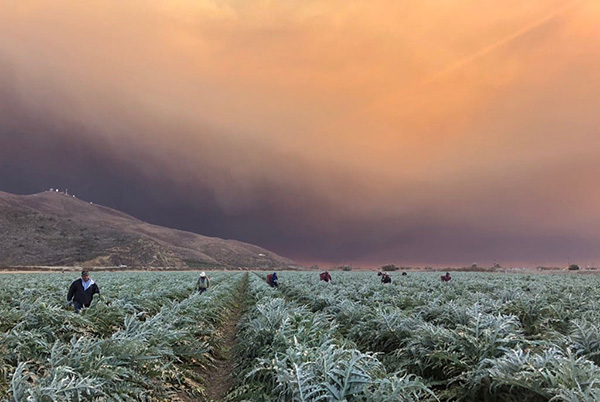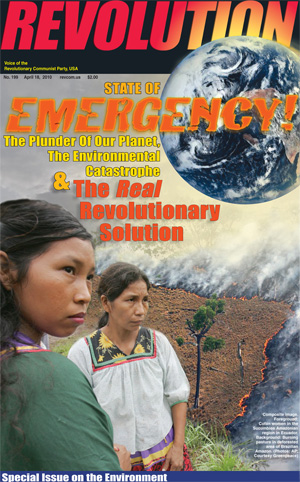California in Flames:
Deadly Climate Change-Driven Fires Ravage the State and the Planet
| Revolution Newspaper | revcom.us

From a reader:
Massive wildfires rage across California. The death toll from the Camp Fire in Northern California is 76, with more than 1,200 people reported missing, as of Sunday, November 18. Every day there are reports of new human remains found in the ashes. In Southern California, the Woolsey Fire started in Thousand Oaks, north of Los Angeles, and burned over the Santa Monica Mountains to the Pacific Ocean, killing three, destroying the homes of actors, singers, and others in wealthy areas of Malibu, Miley Cyrus and Neil Young included. A quarter million people were evacuated.
Fires in California have been intensifying in recent years—in area burned, property destroyed, and lives lost. The Camp Fire is the most destructive and most deadly fire since California began keeping records in 1932. This fire comes just months after the Mendocino Complex Fire (July 2018), the largest fire in California history in terms of area burned. It is less than a year after the Thomas Fire (December 2017), the second largest. In October 2017, the Tubbs Fire, the fourth most deadly and previously the most destructive, destroyed neighborhoods in Sonoma and Napa Counties, killing 22. Nine of the 10 largest wildfires since California started tracking them have taken place since 2000.
While wildfires are a natural part of the forest environment, the increase in number and intensity is being driven largely by human-caused climate change. The 2017 National Climate Assessment Report, prepared by National Oceanic and Atmospheric Administration (NOAA), the National Aeronautics and Space Administration (NASA), and the Department of Energy (DOE), concluded with “high confidence” that climate change is driving the increase of fires since 1980 in the Western U.S. and Alaska.
Plundering the earth for coal, oil, and natural gas to fuel the global economy is deeply woven into the workings of capitalism-imperialism. This system can’t rid itself of this addiction because capitalists are forced to ruthlessly compete with each other for maximum returns and strategic advantage, driving them to use the cheapest and most widely available sources of energy, and treating environmental impacts of their production—like greenhouse gas emissions that are a major cause of climate change—as something external, not factored into their profit-and-loss calculations. Instead, these environmental costs are off-loaded onto society and the planet.
The cutthroat competition that propels capitalism means the capitalists can’t afford to do otherwise—no matter their professed, or even sincere, environmental concerns. This is why in 2017—when report after report warned of the danger of rising global temperatures—the world pumped out MORE greenhouse gases than in any previous year, and globally the last four years have been the hottest ever recorded.
This is why this system cannot be reformed and is incapable of protecting the Earth. This is one more reason why only revolution that overthrows capitalism, and puts a new, radically different socialist system in its place, has a chance to save the planet.
Apocalypse in Paradise
It is these dynamics that are being expressed in the fires and the horrific conditions that they are creating.
The town of Paradise was almost completely destroyed by the Camp Fire: 10,321 buildings, including 8,650 homes. More than 50,000 people were evacuated. As of Thursday morning, the fire was only 35 percent contained.
Paradise is located in the foothills of the Sierra Nevada near the larger city of Chico. The town of 26,000 is a community with many elderly or retired residents. A quarter of its residents are over 65. Many people live in mobile homes. Fourteen percent of the population is below the poverty line.
The fire spread rapidly up the ridge where Paradise is located, driven by winds of 60-70 mph. Roads leading away from the fire turned into parking lots. People drove through fire and smoke too thick to see through, colliding with other cars and driving off embankments. One survivor said it was like “the gates of hell had opened up.” Another said, “Black and red was all you could see.” Some of those fleeing reported seeing horses on fire.
After two wildfires ran right up to the edge of Paradise in 2008, the town made efforts to prepare for future fires. But the speed and intensity of the current fire overwhelmed their plans. Afterwards, melted and burned out hulks of cars lined the road. Chimneys towered like tombstones over a landscape of rubble. Rescue workers with cadaver dogs combing through the ashes looking for human remains were told to look for pots and pipes because human skulls can look like pots and a femur can resemble a pipe.
Thousands have lost everything in the fire and are living in tents or shelters or sleeping on couches. Many have no idea what will come next. It is reported that there are outbreaks of the highly contagious norovirus at one, and possibly more, of the shelters.
There are many stories of heroism and compassion among the people. A nurse drove through flames to a hospital with his car melting around him. Others helped senior citizens to evacuate. Many from throughout Northern California have opened their homes.
Climate Change and Intensifying Fires
Climate change is creating the conditions for these monstrously destructive fires.
There was rainfall this spring in California and this led to increased vegetation. The summer was the second hottest on record in the state. The area around Paradise usually gets about five inches of rain in the summer and early fall. This year there was only one-seventh of an inch. The wet spring followed by the hot, dry summer and fall increased the danger of fire as the relatively abundant vegetation dried out, and made the fire even more ferocious. More than 48 percent of the state is abnormally dry, according to the National Integrated Drought Information System.
As global warming increases temperatures, hot and dry air parches forests and grasslands, making them more combustible and leading to much more intense fires. The intensity of these fires is giving rise to new features that make them more destructive and harder to control. In Paradise, the fires jumped a 300-foot lake at least three times. The Woolsey Fire jumped over Highway 101 several times.
“Fires are moving faster than anyone has ever seen, and barriers that in years past contained fires—bulldozer lines, highways, rivers—are now no match,” the New York Times reported during the last major fires in the state.
Today the fire season in the western U.S. stretches, on average, 78 days longer than in the mid-1980s. In their book Tipping Point for Planet Earth, Berkeley professor Anthony Barnosky and Stanford professor Elizabeth Hadly write, “No longer [in California] is there a ‘fire season’ and an off-season. Fires have become a year-round phenomenon. Wildfires, once recognized as local phenomena mostly controlled by precipitation, are a new global ‘normal,’ mostly controlled by temperature.”
Barnosky and Hadly add that detailed studies on fires in the U.S. West estimate that by 2050, the area burned would be four times what is “normal” today. “The whole character of forests will change forever.”
Building in the Path of Firestorms
Another factor exacerbating the impact of the fire is the extent to which new housing is being constructed in areas where wildlands connect to urban areas. Construction in these areas has increased rapidly in recent decades. The number of homes in these areas increased by 41 percent between 1990 and 2010.
“In these places, it’s not if a fire is going to happen, it’s when it’s going to happen,” former Sacramento Metropolitan Fire District chief Kurt Henke told the Sacramento Bee. “We’re basically building structures right in the path of firestorms. There’s just some places a subdivision shouldn’t be built.”
Under capitalism it is profit and anarchic competition among different groups of capitalists that drive housing construction (and everything else). That is why, despite much damage and loss of life from wildfires over many years, “land use planning for wildfire has yet to gain traction in practice, particularly in the United States,” as one article in a scientific journal put it.
Poisoned Air
Toxic smoke from the Camp Fire has drifted over much of Northern California and even the Central Valley. On November 15, air quality in much of the San Francisco Bay Area, 165 miles from the fire, was rated as “very unhealthy” and continues to get worse. In Sacramento, the air quality was even high into the hazardous range. Many schools have remained closed since the fire started. San Francisco State University and the University of California, Davis, and UC Berkeley announced they would close for the remainder of the week. In San Francisco a gray haze hung over the city, the air smelled like a firepit, and a bright orange moon came out at night. Similar conditions are present in Southern California.
Smoke from wildfires contains particulate matter and gases that can cause all sorts of health issues. Larger particles can cause issues such as coughing and sneezing. It is fine particulate matter, known as PM2.5, that is the most dangerous to long-term health. These particles can get deep into the lungs and are associated with chronic bronchitis, reduced lung function, lung cancer, and heart disease.
Hundreds of thousands of farmworkers, day laborers, landscapers, construction workers, public works employees, and others have no choice but to work in the toxic air. “It’s been horrible,” Kywanna Reed, who works as a traffic controller for a construction company, told In These Times. “I wake up with headaches. I go to sleep with headaches. I have a headache right now, and a bag of headache medicine in the truck. My whole respiratory system is messed up.”
In addition, the Woolsey Fire burned a large part of the Santa Susana Field Lab (SSFL), a site that has been considered “significantly contaminated” by decades of rocket and nuclear reactor testing and a partial nuclear meltdown in 1959. While the California Department of Toxic Substances Control has declared the area safe, this is being disputed by Physicians for Social Responsibility-Los Angeles. Their president, Dr. Robert Dodge, said, “We’re talking about incredibly dangerous radionuclides and toxic chemicals such a[s] trichloroethylene, perchlorate, dioxins and heavy metals. These toxic materials are in SSFL’s soil and vegetation, and when it burns and becomes airborne in smoke and ash, there is real possibility of heightened exposure for area residents.”
Stop the Destruction of the Planet
The intensity, lethality, and frequency of fires in California is a stark example of the ways that the Earth is being damaged, and lives are being lost, due to climate change. This damage cannot be easily repaired, if it can be repaired at all. One of humanity’s goals should be to protect the precious resources of our planet and to leave it in better shape for future generations.
Despite all that is known about climate change, its causes, and the deadly course our planet is on, more and more greenhouse gases are being pumped out year after year and the temperatures keep rising. Only revolution offers a real path to stop this and put society on a radically different course.
Making revolution and changing the catastrophic environmental trajectory that the capitalist system is on—as part of transforming ALL of the oppressive and rotten relations of the system—means making a complete break with the profit-driven, anarchic development of capitalism. We need a whole different way to organize society, and there is a scientific plan for this, which is concentrated in the Constitution for the New Socialist Republic in North America. We CAN build a society that won’t be driven or hampered and constrained by the accumulation of profit and its imperatives—a society that puts protecting the planet for future generations at its foundation, as part of transforming and eliminating all the deep wounds and scars of capitalism-imperialism, throughout the world. A socialist society can inspire and mobilize people, resources, and science in ways that are impossible under the savage and oppressive economic and social relations that exist today. To bring this about, we need an actual revolution.
The damage that has already been done to the global environment is horrific. All who look seriously at the state of climate change know we are in real trouble, but the truth is that a whole new world IS possible. We must act NOW, with the urgency that the situation demands, to make revolution, put an end to the capitalist-imperialist system, and stop the destruction of the planet.

Left and above: The town of Paradise, population 27,000, was almost completely destroyed by the Camp Fire: 10,321 buildings, including 8,650 homes. As of November 18, 76 people are confirmed dead, and more than 1,200 are missing. (Photos: AP)

Hundreds of thousands of farmworkers, day laborers, landscapers, construction workers, public works employees and others have no choice but to work in the toxic air. (Photo: Stephanie Rodriguez, Courtesy of CAUSE)
Why We Need An Actual Revolution And How We Can Really Make Revolution
A speech by Bob Avakian
In two parts:
Watch it, spread it, fund it
Find out more about this speech—and get organized to spread it »
Hey, Trump—Shut Up!
On November 10, with the Camp and Woolsey fires raging for two days and continuing to spread, and as people were pulling charred bodies out of vehicles and homes, Trump issued his first tweet in response: “There is no reason for these massive, deadly and costly forest fires in California except that forest management is so poor. Billions of dollars are given each year, with so many lives lost, all because of gross mismanagement of the forests. Remedy now, or no more Fed payments!” And during a November 17 visit to the fire-devastated town of Paradise, Trump said that in Finland, “they spend a lot of time raking and cleaning” the floor of forests and claimed that because of this, “they don’t have any problem.”
Trump’s words are as cold-hearted as can be imagined. He does not even offer an ounce of sympathy (even phony sympathy) to those who lost their lives or their homes. Instead he spouts a bunch of lies, blames California, and threatens to cut off funding for the state.
Trump’s threats on California have a fascist edge. In threatening to cut off funding to California in the midst of this disaster, he is retaliating—perhaps in a way that will cost lives—against a perceived enemy, in this case the entire state of California.
Trump blames poor forest management for the fires. Trump’s “forest management,” as put forward by his Secretary of the Interior, Ryan Zinke, is to greatly increase logging in U.S. forests. Zinke has referred to groups that oppose logging as “terrorists.” Increased logging would likely make fires even more destructive. For example, the elimination of much of the forest canopy through more logging would allow combustible material on the forest floor to dry up, which can serve as kindling in future fires.
Musician Neil Young, who lost his home in the Woolsey Fire, wrote in a statement in response to Trump: “California is vulnerable—not because of poor forest management, as DT (our so-called president) would have us think. We are vulnerable because of climate change.” Young went on to say, “Imagine a leader who defies science, saying these solutions shouldn’t be part of his decision-making on our behalf.”
Unfortunately, we don’t have to imagine such a leader. Trump and his regime are in power right now. They need to be driven from power and prevented from consolidating their fascist regime before it is too late.
“Not fit caretakers of the earth”
A clip from “Revolution: Why It's Necessary, Why It's Possible, What It's All About, a film of a talk by Bob Avakian” given in 2003. Watch the whole talk at revolutiontalk.net.
The following are two excerpts from an article posted at revcom.us in August 2018.
A Worldwide Inferno
A July 30, 2018 paper by the World Meteorological Organization, a group made up of representatives of 191 nations, reads, “The unusually hot and dry summer in parts of the northern hemisphere has turned fields and forests into fuel for fires which are raging from the Arctic to the Mediterranean and West Coast of North America. These wildfires have caused dozens of fatalities and are devastating large regions, with far-reaching impacts for the environment, ecosystems, human health and the climate.”
In a recent opinion piece in the New York Times, three professors of biology and environmental science argue, “Widespread fires this year have magnified concerns that we are locked in a worldwide pattern of conflagration that is both persistent and catastrophic. Wildfires have been even more pervasive in 2018 in central and northern Europe than last year, including the United Kingdom, Sweden, Denmark, Estonia, Finland, Latvia, Malta, the Netherlands, Poland and Germany. In Greece, east of Athens, some 90 people were killed. (Last year in Portugal, more than 100 people died in wildfires, including at least 30 people who were trapped in their cars when flames engulfed a road.)” (“The Earth Ablaze,” August 8, 2018)
One feature of the 2018 fire season has been the spread of major fires to areas where they have rarely been seen, such as parts of Siberia and Sweden inside the Arctic Circle. In early July, fires in Siberia sent smoke across the Arctic Ocean to Alaska and, eventually, the west coast of Greenland. More than 50 wildfires erupted in Sweden, their worst fires in 75 years.
Rising temperatures are also dramatically changing weather patterns, increasing the frequency of droughts and threatening the livelihoods of billions. The New York Times (August 9) reports that “Climate change could sharply diminish living conditions for up to 800 million people in South Asia [Afghanistan, Pakistan, India, Bangladesh, Nepal, and Sri Lanka], a region that is already home to some of the world’s poorest and hungriest people...” Agriculture and farming in the Middle East, North Africa, Central America, Australia, and other regions are also being hammered by the impacts of global warming.
What Destroying Forests Means for the Planet
Forests play a crucial role in the environment. They provide clean water, lock up carbon (the main cause of climate change), and shelter whole ecosystems. Devastated forests leave birds, mammals, and other living things that rely on them without food, shelter, or the means for survival. Their beauty and biologic diversity enriches us all.
In relation to global warming, the destruction of forest areas contributes to what is called a negative feedback loop, where increased temperatures and other climate changes kill trees and forests. Because the forests no longer lock up carbon, global warming increases, leading to more dying forests, and on and on.
The New York Times op-ed by the three biologists warns, “What has been particularly worrisome in recent years is that the world’s largest forests, the taiga of Russia and its boreal forest cousins that ring the Arctic and store much of the world’s carbon, experienced wildfires at a rate and scale not seen in at least 10,000 years, according to paleoecological records.”
CONSTITUTION For The New Socialist Republic In North America
(Draft Proposal)
Authored by Bob Avakian, and adopted by the Central Committee of the RCP
Get a free email subscription to revcom.us:



